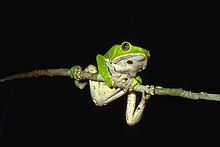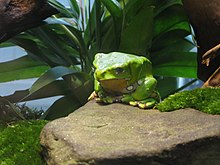Phyllomedusa bicolor
| Phyllomedusa bicolor | |
|---|---|

| |
| Scientific classification | |
| Domain: | Eukaryota |
| Kingdom: | Animalia |
| Phylum: | Chordata |
| Class: | Amphibia |
| Order: | Anura |
| Family: | Hylidae |
| Genus: | Phyllomedusa |
| Species: | P. bicolor
|
| Binomial name | |
| Phyllomedusa bicolor (Boddaert, 1772)
| |

| |
| Synonyms | |
| |
Phyllomedusa bicolor, the giant leaf frog, bicolor tree-frog, giant monkey frog,
Description
Males measure 91–103 mm (3.6–4.1 in) and females 111–119 mm (4.4–4.7 in) in snout–vent length. The
Distribution and habitat
It is found throughout the
Ecology and behaviour

The giant leaf frog is a nocturnal, arboreal frog. Males call from trees in tropical humid forests. Males fight each other for mating rights by using their heads to attempt to separate another male who is attached to a female. Males fend off rivals using a series of aggressive calls and use their hind legs to push away the rival.[4] During mating season, males may be targeted more by predators as the fights between males are very vocal and can be easily heard by predators. However, to combat this, giant leaf frogs produce peptides in their skin that serves as a chemical defense.[4] Giant leaf frogs reproduce like most frog species through amplexus, where the male climbs onto the female's back to fertilize the eggs.[4] The female and male construct a leaf-nest above forest pools, where the eggs are laid in a gelatinous mass of about 70 cm above the water. The eggs hatch from these nests in approximately 14 days, and the tadpoles fall into the water, where they continue the development into adult frogs. Peak reproduction occurs during the rainy season.[3][4] Eggs of the giant leaf frog are heavily predated and have a predation rate of up to 61%. Species that prey on the eggs include Staphilynid beetles, phorid flies, mammals – specifically capuchin monkeys– and other predators, such as snakes. The eggs are predated because they are source of protein for predators.[5]
Conservation
The
Medicinal use
The skin secretion of the giant leaf frog is known as Vacina do sapo (frog vaccine) and contains the opioid peptides deltorphin, deltorphin I, deltorphin II and dermorphin.[6][7][8][9] The secretion, known as Kambo or Sapo, has seen increasing popularity in cleansing rituals, where it induces intense vomiting.[10][11]
References
- ^ . Retrieved January 28, 2024.
- ^ Frost, Darrel R. (2015). "Phyllomedusa bicolor (Boddaert, 1772)". Amphibian Species of the World: an Online Reference. Version 6.0. American Museum of Natural History. Retrieved 25 August 2015.
- ^ a b c "Phyllomedusa bicolor". AmphibiaWeb: Information on amphibian biology and conservation. [web application]. Berkeley, California: AmphibiaWeb. 2015. Retrieved 25 August 2015.
- ^ .
- S2CID 86277566.
- PMID 2544892.
- PMID 11043404.
- PMID 8981054.
- PMID 9949868.
- PMID 27421671.
- ^ Daly, Max (May 10, 2016). "How Amazonian Tree Frog Poison Became the Latest Treatment for Addiction". Vice. Archived from the original on September 7, 2018. Retrieved October 31, 2018.
External links
![]() Media related to Phyllomedusa bicolor at Wikimedia Commons
Media related to Phyllomedusa bicolor at Wikimedia Commons

